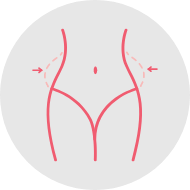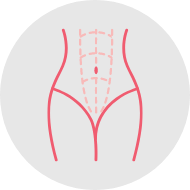Abdominoplasty Toowoomba
Procedures
Abdominoplasty
Abdominoplasty is a surgical procedure that may be considered for patients with changes in skin, tissue, or abdominal muscle separation. These changes can occur following pregnancy or significant weight loss and may result in excess tissue in the lower abdominal region as well as functional concerns such as lower back pain, urinary frequency and skin irritation under the abdominal apron.
In some cases, this tissue may collect around previous surgical scars, such as those from a caesarean section. Abdominoplasty may be discussed during a consultation to assess individual concerns and determine suitability.
There are specific eligibility criteria that must be met for Medicare assistance for abdominoplasty. Additional support may be available from private health insurance for patients who meet the eligibility criteria for Medicare assistance. Patients are advised to check eligibility and coverage with their health fund before proceeding.
Treatment Outcomes

May address excess skin and soft tissue in the abdominal region

May support the position of weakened or separated abdominal muscles

May assist with functional concerns following pregnancy or weight changes
Allure
Abdominoplasty (Tummy Tuck) Before and After – Patient Results
Disclaimer: The outcomes shown are only relevant for these patients and do not necessarily reflect the results other patients may experience, as results may vary due to many factors including the individual’s genetics, diet and exercise.



FREQUENTLY ASKED QUESTIONS
How can a patient prepare for abdominoplasty?
Preparing for recovery is an important step. It may be helpful to arrange transport home and organise assistance for daily tasks in the initial days following discharge. Setting up a space for rest and preparing nourishing meals ahead of time can reduce activity during early recovery.
Who may consider abdominoplasty?
Abdominoplasty may be considered for patients with concerns such as excess skin, localised fat, or reduced abdominal muscle support. These changes may develop following weight fluctuations, pregnancy, or ageing. Suitability is based on individual assessment. Patients are usually in good general health and free from active skin conditions in the abdominal area. Smoking cessation is recommended before surgery.
What happens during abdominoplasty?
The surgical approach varies depending on factors such as skin and tissue changes and whether abdominal muscle repair is needed. The chosen technique is determined by the practitioner and discussed in detail during your consultation.
Is a hospital stay required?
An overnight hospital stay is usually required after abdominoplasty. This allows healthcare staff to monitor each patient and provide support during the early stages of recovery. In some cases, a longer stay may be recommended based on individual needs and the extent of the procedure.
What is recovery like?
Recovery timelines differ between patients. Some assistance at home may be needed for daily tasks during the early days. Light movement is often encouraged to support circulation. Activities that require significant effort are generally avoided until cleared by your practitioner. Compression garments are recommended as part of the post-operative plan and are generally worn for up to six weeks following an abdominoplasty. Patients are advised to not drive for up to 14 days after their procedure.
When are treatment outcomes visible?
Changes in the abdominal area may be noticed after the procedure; however, swelling and tissue settling can continue for several months. The appearance of the area may change during this time. Results vary between patients depending on individual healing and other factors. Patients can support their recovery with health eating and exercise (once approved to return) and consulting with a Physiotherapist after surgery to assist in re-engaging the abdominal muscles after the repair.
Are there risks associated with abdominoplasty?
Abdominoplasty is a surgical procedure and carries potential risks. These may include bleeding, infection, delayed wound healing, fluid collection (seroma), skin or fat necrosis, changes in skin sensation, and visible or thickened scarring. Other possible complications include blood clots, wound separation, or the need for further surgery. Rare but serious risks, such as deep vein thrombosis or adverse reactions to anaesthesia, can also occur.
These risks will be discussed in more detail during a consultation. Patients are encouraged to provide a full medical history and disclose any medications or health concerns to support a thorough and appropriate assessment.
How can I find out if this procedure is suitable?
A consultation is required to assess concerns and determine whether abdominoplasty may be appropriate. This includes a physical examination and discussion of medical history, recovery expectations, and possible treatment options.

